Inference with Statistics¶
# Some code to set up our notebook for data science!
from datascience import *
import numpy as np
%matplotlib inline
import matplotlib.pyplot as plots
plots.style.use('fivethirtyeight')
import warnings
warnings.simplefilter(action="ignore", category=FutureWarning)
warnings.simplefilter(action="ignore", category=np.VisibleDeprecationWarning)
from ipywidgets import interact, interactive, fixed, interact_manual
import ipywidgets as widgets
1. Snoopy’s Fleet¶
We will create a simulation for the empirical distribution of our chosen statistic.
At true inference time, we do not know N.
However, in our simulation we can make an assumption about what N might be so we can evaluate how “good” our chosen models and statistics could be.
# Our population. Only Snoopy knows the population. We don't. All we can do
# is call `sample_plane_fleet` to observe planes flying overhead.
N = 300
population = np.arange(1, N+1)
def sample_plane_fleet(sample_size):
"""
Return a random sample of planes from Snoopy's fleet.
"""
return np.random.choice(population, sample_size)
sample = sample_plane_fleet(10)
sample
array([239, 3, 112, 181, 105, 165, 116, 271, 293, 15])
Option 1: Sample Statistic is the max plane number¶
# The outcome we care about is our chosen statistic evaluated on the sample
# Chosen statistic option 1: max of sample
outcome = max(sample)
outcome
293
Let’s put this all together using our simulation algorithm.
def simulate_plane_fleet(sample_size, num_trials):
all_outcomes = make_array()
for i in np.arange(0, num_trials):
sample = sample_plane_fleet(sample_size)
outcome = max(sample)
all_outcomes = np.append(all_outcomes, outcome)
return all_outcomes
all_outcomes = simulate_plane_fleet(10, 1000) # sample size is 10, num trials is 1000
results = Table().with_columns("Statistic Option 1: Max Sample", all_outcomes)
results.hist(bins=np.arange(1, 2 * N, 10))
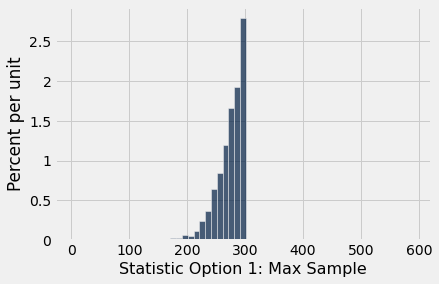
Let’s generalize a bit and create function that takes the statistic and runs the whole experiment
Option 2: Sample Statistic is Twice the Mean¶
Let’s generalize a bit and create function that takes the statistic and runs the whole experiment
def planes_empirical_statistic_distribution(sample_size, num_trials, statistic_function):
"""
Simulates multiple trials of a statistic on our simulated fleet of N planes
Inputs
- sample_size: number of planes we see in our sample
- num_trials: number of simulation trials
- statistic function: a function that takes an array
and returns a summary statistic (e.g. max)
Output
Histogram of the results
"""
all_outcomes = make_array()
for i in np.arange(0, num_trials):
sample = sample_plane_fleet(sample_size)
outcome = statistic_function(sample)
all_outcomes = np.append(all_outcomes, outcome)
results = Table().with_columns('Empirical Distribution, Statistic: ' + statistic_function.__name__,
all_outcomes)
results.hist(bins=np.arange(1, 2 * N, 10))
# sample size is 10, num trials is 1000, statistic is max
planes_empirical_statistic_distribution(10, 1000, max)
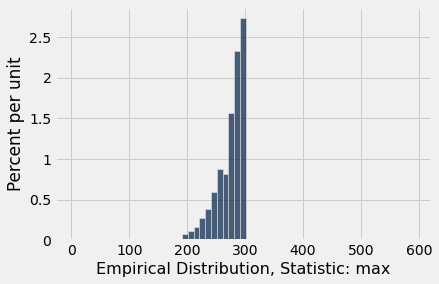
Our second option for the statistic:
def twice_mean(sample):
"""Twice the sample mean"""
return 2 * np.mean(sample)
# sample size is 10, num trials is 1000, statistic is twice mean
planes_empirical_statistic_distribution(10, 1000, twice_mean)
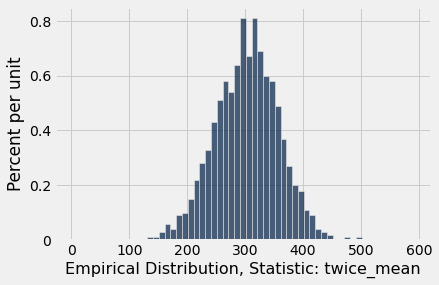
Effects of Sample Size and Simulation Rounds¶
def visualize_distributions(N, sample_size, num_trials):
"""A single function to run our simulation for a given N, sample_size, and num_trials."""
population = np.arange(1, N+1)
# Builds up our outcomes table one row at a time. We do this to ensure
# we can apply both statistics to the same samples.
outcomes_table = Table(["Max", "2*Mean"])
for i in np.arange(num_trials):
sample = np.random.choice(population, sample_size)
outcomes_table.append(make_array(max(sample), 2 * np.mean(sample)))
outcomes_table.hist(bins=np.arange(1, 2 * N, 10))
_ = widgets.interact(visualize_distributions, N=(100, 500, 10),
sample_size=(1, 100, 1),
num_trials=(10, 5000, 100))
3. Mendel and Pea Flowers¶
# Mendel owned 929 plants, of which 709 had purple flowers
observed_sample_size = 929
observed_purples = 709 / observed_sample_size
observed_purples
0.7631862217438106
# 3:1 ratio of purple:white, or 75% purple, 25% white
hypothesized_proportions = make_array(0.75, 0.25)
In the Python library reference, we see can use the function sample_proportions(sample_size, model_proportions).
sample = sample_proportions(observed_sample_size, hypothesized_proportions)
sample
array([0.74058127, 0.25941873])
Each item in the array corresponds to the proportion of times it was sampled out of sample_size times. So percent purple in sample:
percent_purple = 100 * sample.item(0)
percent_purple
74.05812701829925
Let’s use our same simulation algorithm we return to over and over.
def simulate_purple_flowers(observed_sample_size, hypothesized_proportions, num_trials):
all_outcomes = make_array()
for i in np.arange(0, num_trials):
simulated_sample = sample_proportions(observed_sample_size, hypothesized_proportions)
# outcome: we only want the percent of the purple, we can drop the percent white
outcome = 100 * simulated_sample.item(0)
all_outcomes = np.append(all_outcomes, outcome)
return all_outcomes
all_outcomes = simulate_purple_flowers(observed_sample_size, hypothesized_proportions, 1000)
results = Table().with_column('% of purple flowers', all_outcomes)
results.hist()
plots.title('Simulated Outcomes\n observed sample size=' + str(observed_sample_size));
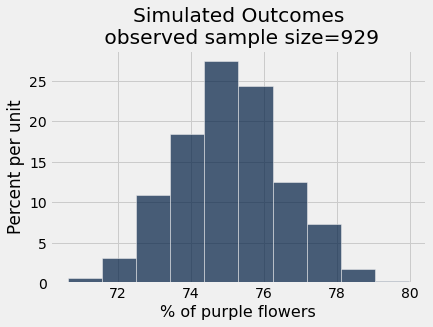
Connecting these pieces together:
In Mendel’s model, he hypothesized getting purple flowers was like flipping a biased coin and getting heads 0.75 percent of the time.
We simulated outcomes under this hypothesis.
Now let’s check if the observed data (that there were 76.3% purple flowers in one sample, Mendel’s own garden) “fits” with the simulated outcomes under the model
results.hist()
_ = plots.scatter(100 * observed_purples, 0.005, color='red', s=70, zorder=3)
plots.title('Simulated Outcomes\n observed sample size=' + str(observed_sample_size));
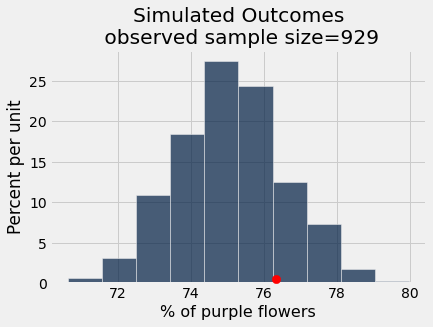
differences_from_model = Table().with_column('abs(sample statistic - model parameter)',
abs(all_outcomes - 75))
differences_from_model.hist()
_ = plots.scatter(abs(100 * observed_purples - 75), 0.005, color='red', s=70, zorder=3);
plots.title('Differences from Model \n Parameter (75% Purple)');
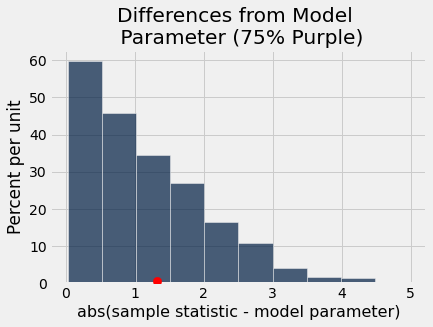
Once again, let’s use computation to abstract away the variables that we have the power to change, and the parts of the code that never change.
def pea_plants_simulation(observed_sample_size, observed_purples_count,
hypothesized_purple_proportion, num_trials):
"""
Parameters:
- observed_sample_size: number of plants in our experiment
- observed_purples_count: count of plants in our experiment w/ purple flowers
- hypothesized_purple_proportion: our model parameter (hypothesis for
proportion of plants will w/ purple flowers).
- num_trials: number of simulation rounds to run
Outputs two plots:
- Empirical distribution of the percent of plants w/ purple flowers
from our simulation trials
- Empirical distribution of how far off each trial was from our hypothesized model
"""
observed_purples = observed_purples_count / observed_sample_size
hypothesized_proportions = make_array(hypothesized_purple_proportion,
1 - hypothesized_purple_proportion)
all_outcomes = make_array()
for i in np.arange(0, num_trials):
simulated_sample = sample_proportions(observed_sample_size, hypothesized_proportions)
outcome = 100 * simulated_sample.item(0)
all_outcomes = np.append(all_outcomes, outcome)
#plots
percent_purple = Table().with_column('% of purple flowers', all_outcomes)
percent_purple.hist()
_ = plots.scatter(100 * observed_purples, 0.005, color='red', s=70, zorder=10)
plots.title('Simulated Outcomes\n observed sample size=' + str(observed_sample_size));
distance_from_model = Table().with_column('abs(sample statistic - model parameter)',
abs(all_outcomes - 100 * hypothesized_purple_proportion))
distance_from_model.hist()
_ = plots.scatter(100 * abs(observed_purples - hypothesized_purple_proportion),
0.005, color='red', s=70, zorder=10)
plots.title('Differences from Model \n Parameter (' + str(hypothesized_purple_proportion) + '% Purple)');
pea_plants_simulation(929, 705, 0.75, 1000)
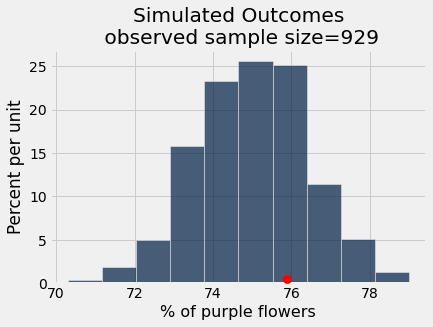
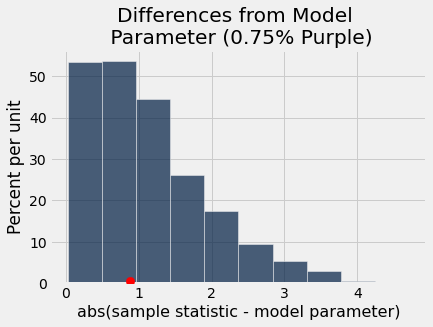
pea_plants_simulation(929, 506, 0.75, 1000)
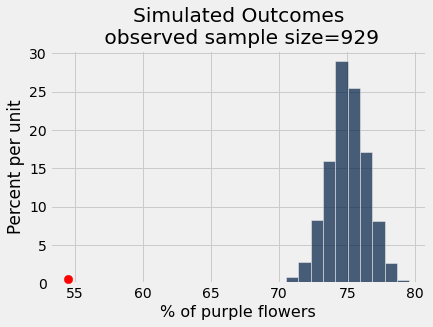
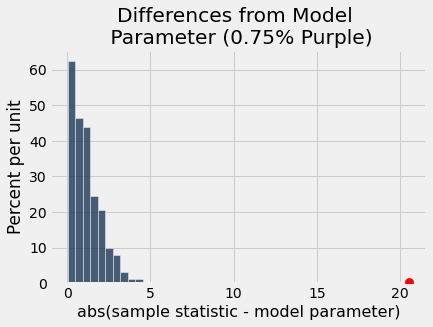
As an interactive visualization:
_ = widgets.interact(pea_plants_simulation,
observed_sample_size = fixed(929),
observed_purples_count = (0,929),
hypothesized_purple_proportion = (0,1,0.01),
num_trials=(10, 5000, 100))
